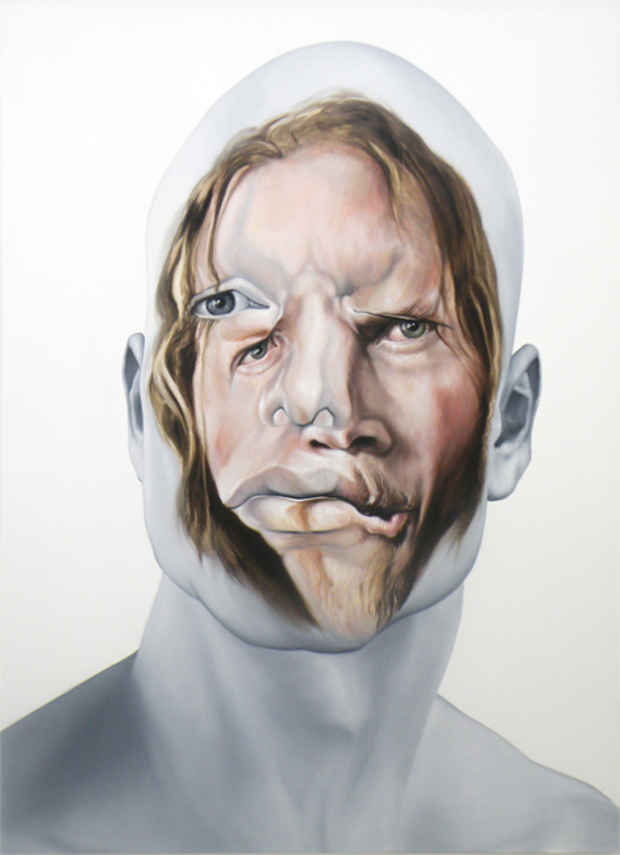Christophe Avella-Bagur “Floating Souls, Spirit of Resilience - Part 2 “
Galerie Richard

This event has ended.
This exposition follows suit to his solo exhibition at Galerie Richard, Paris at the beginning of the year. These new works are a continuation of Avella-Bagur’s series Faces FS (Floating Souls), which began in 2005. This series is characterized by the representation of the male and female body archetype portrayed using light gray color, in which a second flesh colored portrait is positioned. Thestandardized and perfect modeled body is painted in flat tints, while the portrait is painted in depthful flesh tones, creating a more life-like pictorial image. While the first body is presented as perfectly realistic, the displacement of the second figure causes distortion, often appearing as disturbing and grotesque defomities, such as those found in the paintings of El Greco and Goya. The artist challenges us to consider the societal inclination towards human standardization, caused by scientific developments and social conditioning.
Christophe Avella-Bagur’s first exhibition in New York consisted of large vertical portraits on pristine white canvas. In his new paintings, we find similar subjects that have come out of this white lab environment. In Dark Water a figure stands upright in a gray boat. The boat floats on a liquid mass as red and multicolored flames burst into the white, as if the canvas itself has caught fire. Christophe Avella-Bagur ‘s Dark Water shows an allegory of human life as equivalent to a ride on a river boat, evoking thoughts of Thomas Cole’s four works, The Voyage of Life. Instead of the landscape acting as a reassuring force, as in the works of Cole, Bagur’s subject is launched into a psychologically disturbing setting. His future is both unknown and unsettling.
In FS16 Gorgona 2.0 (PL), the artist adresses the mythological portrait of the Gorgon, the three sea monsters of the sea gods Phorcys and Céto. The Gorgon is represented in the form of hair, intertwined and composed of venemous snakes. A portrait of a blonde woman appears skewed in a left corner on the standardized face portrait, the snakes crawling on top of the hair. Here, Bagur departs from his use of a white background ; instead, he depicts a burning city with a cloudy and dark sky as the landscape. Positioned between the portrait and the landscape is a pale of yellow color.
For the portrait, Face FS160 Happy Five Bridget B, the artist has abandoned the white neutral background again for a joyous and festive lettering of Happy Birthday. This colorful composition gives a nod to the artists of American Pop Art. In certain works Avella - Bagur shows the breadth and diversity of his field of pictorial investigation, as well as addressing major questions of defining human identity. Through the representation of contemporary portraiture, Avella-Bagur emphasizes the humanity of these individuals on a highly personal level.
In Avella- Bagur’s Paris exhibtion, scultpures were included as well. For his New York show we present the three dimensional work Face FS151 Skin Control. This amazing self-portrait features an arm coming out of the canvas holding a facial skin, modeled after the artist. This work is in reference to St. Bartholomew’s portrayal in Michelangelo ‘s fresco of the Last Judgment, in which some hypothesize Michelangelo depicted his own self portrait in the flayed skin of St. Bartholomew.
I paint keeping in mind the long line of artists who have gone before me and with whom I live everyday like with friends, with whom I have spiritual relations, mystics. I paint the human because there is no more valid subject than our own condition.My work exposes our current confrontation between standardization of being, thinking, lifestyle with a human against his free will, its uniqueness, its flaws but also its singularity . My works coalesce between two worlds : a world where man is a product without a soul, leaving a string of mass production, interchangeable and therefore worthless, and a second moral universe, where the singular being is open to the possible blunders of trial and error, but with the freedom to act and to choose his destiny.That is why my works expose two faces, a fight for supremacy, for the battle is fierce and nobody is still winning. - Christophe Avella - Bagur
The major work in this exhibition is undoubtedly Face FS1812 Pilgrimage to the New World, a painting of two meters by four meters. Inspired by the Procession of St. Isidore of Francisco de Goya in the Prado, the meaning of Avella Bagur’s piece is the same: the most complex representation of the existence of man, his confusion, his hopes, his questions of destiny, his rage of destruction and self- destruction. Nonetheless, Bagur is neither melancholic, nor deaf or isolated as Goya was at age 73, when he painted A Procession to San Isidro. Face FS136 The Good Wine depicts a self portrait raising a glass to celebrate the viewer, with a hand on his stomach, conveying he has just enjoyed a heartly meal. Simultaneously, his wife picks grapes from a vine the same height as a tree, in reference to the tree of forbidden fruit. For the first time, the flesh colored face completely takes over the humanoid frame. The artist shows us, with a touch of humor, the virtues of wine in reference to the of the XVIth century flemish masters.
Christophe Avella-Bagur reveals an unambiguously contemporary kind of painting all while remaining an heir to the history of figurative representation. He puts together a new vision of human identity based upon a virtual universe.
Media
Schedule
from April 05, 2014 to April 26, 2014